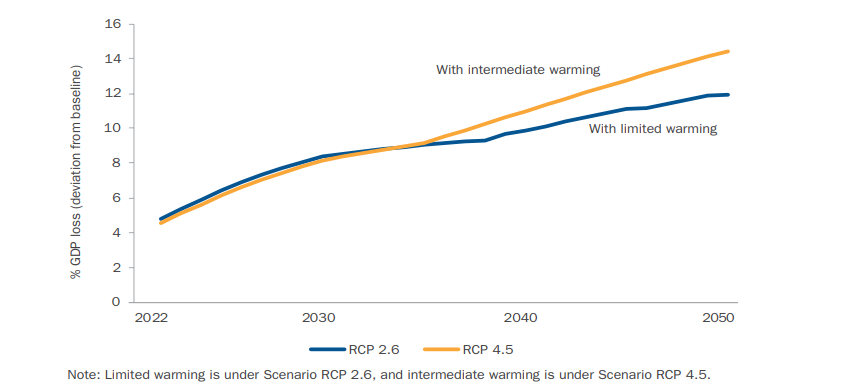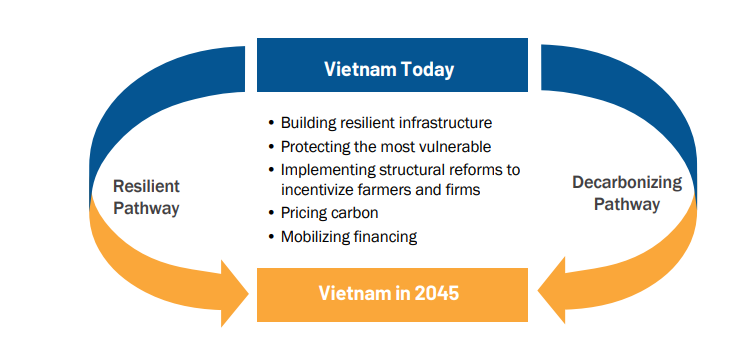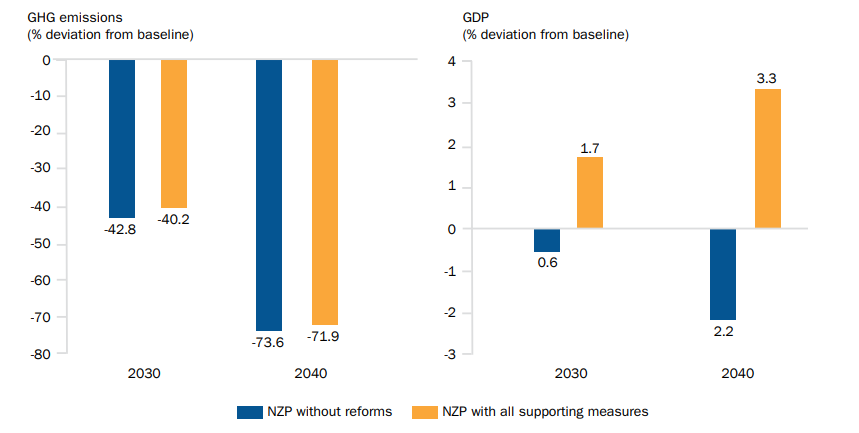One hundred and eighty-four billion US dollars at current value – that’s the estimate of the potential investment opportunities for the private sector in the years to 2040 to help Vietnam on a climate resilient and net zero development pathway.
The estimate is revealed in the new Vietnam Country Climate and Development Report (CCDR) produced jointly by the World Bank Group and one of the first in a series of country-level diagnostics that lay out a new path to reconcile Vietnam’s growth and climate ambitions.

Vietnam has set twin goals: to become a high-income country by 2045 and to achieve carbon neutral status by 2050. But as the CCDR starkly lays out, it’s a country already facing significant climate impacts on its economy and national welfare. The costs are already starting to undermine growth. In 2020, Vietnam lost $10 billion, or 3.2 per cent of its GDP, to climate change impacts.
And to underscore the need to mitigate climate change, the CCDR says that while the country has historically had very low greenhouse gas emissions, over the past two decades it has posted some of the highest emission growth rates in the world. Vietnam is now one of the most greenhouse gas-intensive economies in East Asia.
If nothing is done, under a business-as-usual scenario with limited global mitigation efforts, climate change could cost Vietnam up to 14.5 per cent of GDP annually over roughly 30 years. And without inclusive adaptation responses, climate change impacts have the potential to push a million people into extreme poverty in less than a decade.
To fulfill its future growth ambitions and reduce its vulnerability to climate risks, the CCDR recommends Vietnam shift its development model, by embarking on two distinct pathways – one to build resilience and the other to mitigate climate change by decarbonizing growth.

The CCDR says energy transition should be the backbone of the country’s program and many investment decisions will have to be frontloaded to be cost-effective. With the right mix of policies and strategies, Vietnam can leverage its decarbonization efforts to advance development objectives, so that achieving net zero does not reduce GDP growth.
Overall, it’s a move that comes with a hefty price tag. Embarking on dual pathways of adaptation and mitigation will require investments of around $368 billion to 2040, or 6.8 per cent of GDP each year at current value. Government resources alone are certainly not enough to meet these financing needs, and mobilizing massive amounts of private capital will therefore be pivotal.

The CCDR points out Vietnam’s private sector is already under pressure. Around $300 billion of assets held by the commercial and industrial sector are vulnerable to climate-related disasters. Many firms are already reporting climate change impacts that significantly affect their income due to disrupted operations or reduced labor productivity. A 2020 analysis found climate-related damage, occurring annually, could amount to as much as 70-80 per cent of the total revenue of some small and medium-sized enterprises (SMEs). To change that, the private sector will have to make substantial investments - $228 billion through 2050 - just to upgrade their assets to adapt to climate change.
The question is how to unleash the private sector?
A good start could be to reallocate domestic private savings towards climate-related projects, among others. Also, aggressive efforts could help mobilize private financing in the range of 3.4 per cent of GDP annually. The CCDR says this can be achieved by mobilizing green credit by banks, developing market-based instruments such as green equities and green bonds, and applying de-risking tools. Though green finance is in its infancy in Vietnam, the right public policy can help banks overcome bottlenecks through regulatory reforms and incentives for both credit providers and borrowers.
In this context, the government should consider assessing climate-related risks for the country’s financial sector, and this can further inform green finance policies. About 55 per cent of total loans by banks go to businesses and people in climate-vulnerable regions, including southern provinces, the Mekong Delta, and coastal provinces.
In addition, more targeted actions on climate-related investments in infrastructure, including adjusting the public-private partnership (PPP) legal framework, will be crucial. This will help create incentives for greater private sector participation in climate resilient-infrastructure projects by allowing them to share risks on investments. Further, a life-cycle asset management approach could be especially useful for Vietnam, where a large proportion of the needed finance could be mobilized from the private sector through management contracts or PPPs. Under this system, the government retains control over the assets but transfers the daily operations to the private sector.
The CCDR highlights that these initiatives should be complemented by structural and policy reforms. It says that over the medium to long term, reforming State-Owned Enterprises (SOE) and opening the market up to greater private sector participation will be essential to achieving much of the climate agenda.
For the private sector, investment opportunities also lie in tackling Vietnam’s main emitting sectors, including energy, transport, agriculture, and industry. However, the large financing needs—$81.3 billion at current value - of decarbonizing these four sectors calls for accelerated reforms of the investment climate for increased private sector participation and mobilization of concessional loans. Also, facilitating rapid renewable energy deployment could help with transparency and competitive procurement procedures, further encouraging the private sector.
The bottom line is that if Vietnam fully embraces the pathways to boost resilience and decarbonize, it's people, the environment and industries are all set to benefit. Drawing in greater private sector involvement, and greening the economy, will help create new jobs and trade opportunities. And it will also help safeguard Vietnam’s competitiveness in global markets - as under the current scenario, the country’s trademark is at risk from climate change.
So, as Vietnam moves closer to its development goals with the right mix of policies and strategies, the private sector must play a key role in climate action. That will help Vietnam better balance its growth with increasing climate risks, blowing any dark clouds away.









 Google translate
Google translate